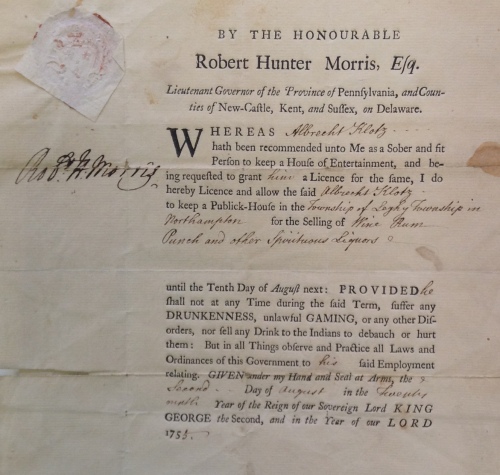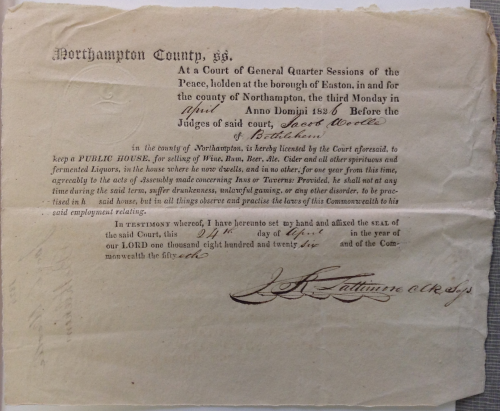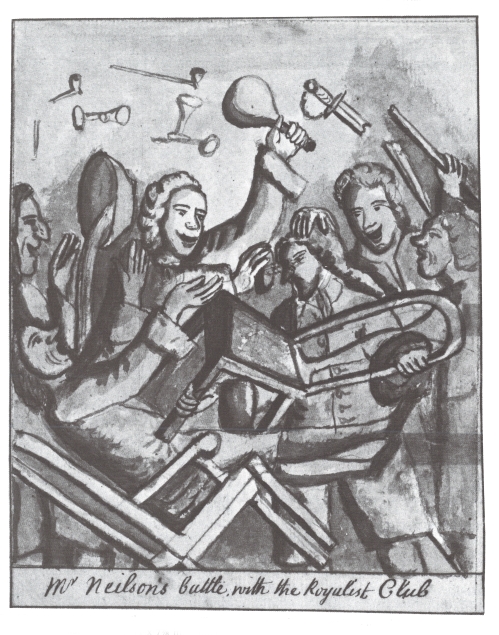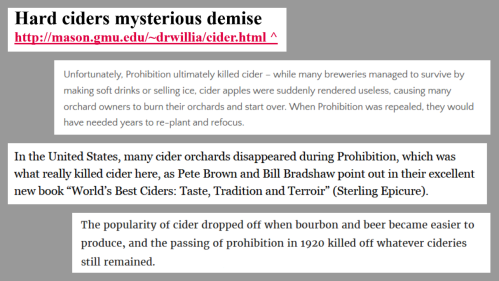This is the next installment in our continuing series, “Did Prohibition Prohibit Cider?”
____________________________________________________
It’s easy to think that Prohibition was the first attempt to legally control alcohol consumption, but it’s not. Almost as long as there has been alcohol in America, there has been alcohol control. In Colonial America that legal control was exerted through anti-intoxication laws, dispensing licenses, and access control.(1)
Pennsylvania, for example, took intoxication very seriously. Drunkenness was officially illegal throughout the entire eighteenth century.
In 1700 the Pennsylvania Assembly passed, “The Law Against Drunknenness and Healths-Drinking.” It expressly outlawed, “every person disordering or abusing him or herself with drink unto drunkenness, and every person suffering such excess at their houses, and every person that shall drink healths [toasts] which shall provoke people to excessive drinking…” In January 1706, the Assembly passed the similar, but slightly reworded law, “Act Against Drunkenness and Drinking of Healths.” The 1779 “Act for the Suppression of Vice and Immorality,” continued to outlaw intoxication using very similar language as the “Act Against Drunkenness,” (see Section IV). In 1786 the Assembly felt that the 1779 law was not, “fully and duly executed and enforced…” and passed, “An Act for the Prevention of Vice and Immorality and Unlawful Gaming and to Restrain Disorderly Sports and Dissipation.” Section III, yet again, stated that no one shall drink to intoxication.
This concern over intoxication spilled into taverns. We think of early American taverns as places flowing with drunken fun. They certainly were, but they were also places for public discourse, education, and entertainment. They were central to their communities and were seen as places where community standards needed to be upheld. Tavern licenses were granted to those seen as being a, “sober and fit person to keep a house of entertainment…” As specified in the tavern license, part of a tavern keeper’s job was to prevent indecent behaviors, including drunkenness, in their establishment.

During most of the eighteenth century, tavern keepers were also to keep alcohol from Indians. 1755 Pennsylvania tavern license. Courtesy of the Moravian Archives, Bethlehem, PA.

Seventy years later, Indians are no longer a concern and the wording is different. The intent remains the same though – no drunkenness allowed in the tavern. 1826 Northampton County, Pennsylvania tavern license. Courtesy of the Moravian Archives, Bethlehem, PA.
Though everyone was legally expected to refrain from drinking to excess, colonial American leaders felt they needed to limit certain people’s access to alcohol. They passed additional laws prohibiting Indians, enslaved people, servants (indentured, domestic, and apprentices), and even working class white men from having ready access to hard liquor.

“An Act Against the Selling of Rum and Other Strong Liquors to the Indians.” Passed October 28, 1701. The Charters and Acts of Assembly of the Province of Pennsylvania
__________________

“A Supplementary Act to a Law of This Province, Intituled, An Act That No Public-House or Inn, Within This Province, Be Kept Without Licence.” Passed August 26, 1721. The Acts of Assembly of the Province of Pennsylvania.
__________________

“An Act for the better regulating the Retailers of Liquors near the Iron Works and elsewhere.” Passed March 5, 1726. The Acts of the Assembly of the Province of Pennsylvania.
At the same time they’re passing these laws, gentry men’s drinking habits are getting a pass. Middling and gentry men could drink whatever they wanted and to excess, often in social, all-male gatherings.

The genteel could run riot, but no one else could. “Mr Neilson’s Battle With the Royalist Club,” attributed Dr. Alexander Hamilton. Maryland Historical Society.
Like many laws attempting to prohibit sin and vice, there was more hope than success in them. Whether at home or at the tavern, people drank what they wanted and got drunk.
NEXT TIME: The temperate beginnings of Temperance.
************************************
- The majority of other alcohol-related laws covered production, sales, and taxes.




 At the Federal level there’s
At the Federal level there’s 